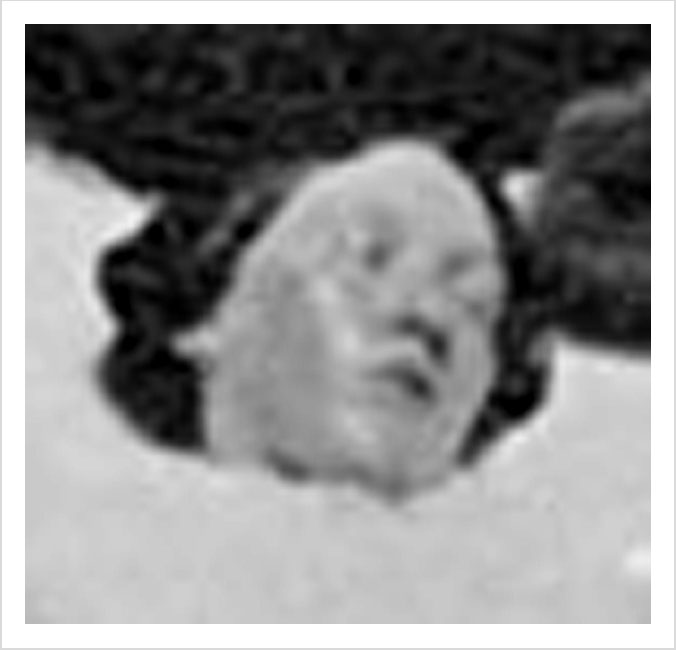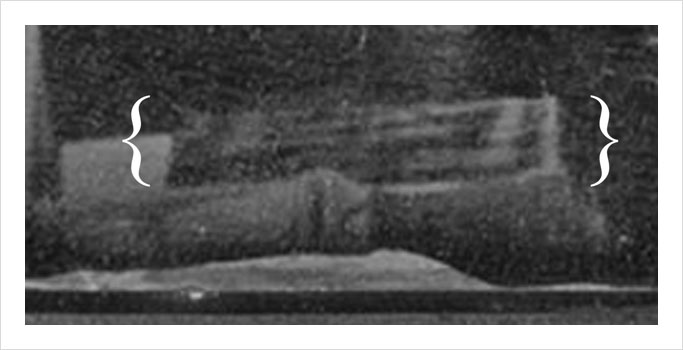

Enlarged detail from EDD No. 2. It is impossible to tell if the distortion around her mouth was caused by epulis, or was simply motion blur. The glow of "Ether-rash" (flushing, erythema) was caused by irritation of the sulphuric ether. The daguerreotype is the property of MGH and archived at the Fogg Museum (object no. 2.1979).
Ex-ante evidence that dates EDD No. 2 based on first-use of the sponge to express ether is tenuous. And even if it were true, would not be important enough to memorialize with a photograph unless its innovator, Dr. J. Mason Warren, were holding the sponge, preferably with a painting in the background of a medieval physician holding the spongia soporifera soaked in mandrake juice. The first-use-sponge argument is what stakes the Lowry & Lowry attribution that Ether Dome Daguerreotype No. 2 was taken on April 3, 1847, and captured the 25-yr-old patient Athalana Golderman undergoing etherization before her treatment with the actual cautery. The Lowrys based their claim on a loose interpretation of the earliest known MGH hospital record for a sponge etherization.(91) They also identified Heywood as the etherizer and supported their arguments with a reference to a description of the daguerreotype illustrating the Presidential Address delivered by J. C. Warren, Jr., as follows:
| [NOTE.—The illustration represents the operating-theatre of the Massachusetts General Hospital in the winter of 1847. The sponge used here is known as the first sponge with which ether was given. This method was adopted in February, 1847, by Dr. J. Mason Warren. The surgeons whose portraits appear in this picture are, on the patient's left, Dr. John C. Warren, Dr. Samuel Parkman; on the patient's right, Dr. J. Mason Warren and Dr. Townsend. The etherizer is probably Dr. Heywood. The daguerrotype from which the photogravure is taken has been in the possession of the writer's family since that time.]—John Collins Warren, Jr. (92 »») |
Warren's treatise on the history of ether was written almost fifty years later and it's not surprising that an error or two slipped in, such as setting in motion the mistaken identity of the etherizer. I believe he was also wrong about the date and chronical of the young woman's surgery. Haridas placed a question mark alongside the attribution of Heywood and stressed that the daguerreotype "documents an early use of the sponge," but that "earlier uses of the sponge at MGH may not have been documented," further noting that the sponge had been taken up in England as early as February.(93) A factual record of the first use of the sponge is found in John Collins Warren's monograph 1848 monograph on ether in which he states the following, "Dr. Mason Warren first used the sponge for children in February, 1847" (footnote, p. 9: »»)
There are several other scenarios that can be claimed for EDD No. 2, based on the age and constitution of the patient, including a leg amputation prosecuted on April 3 for an incurable necrotizing disease of the tarsal bones. The patient's name, Ann Kerr, is found on Hayward's table of large limb amputations conducted at Mass. General up to January 1850.(94 »») Trace evidence supporting a leg amputation, not necessarily occurring on April 3, 1847, include what strikes my eye as amputation instruments arrayed on a table in the foreground, and what may be a leg prosthesis – for the purpose of demonstration – or a sleeve to protect the dressing and suspend or otherwise secure the leg:

There are several other women in age close to the appearance of the patient in the daguerreotype, and recorded on Bigelow's table, including: 1.) January 17, a 27-yr-old treated for malignant disease of labium. 2.) March 13, a 24-yr-old treated for encysted tumor. 3.) April 24, a 20-yr-old treated for polypus nasi. 4.) May 8, a 23-yr-old twice treated for onychia. 5.) July 3 & 21, a 19-yr-old treated for epulis. The July 3 surgery for epulis is particularly noteworthy because the views presented by EDD Nos. 3-5 favor Francis Manuel's surgery prosecuted that same day, discussed below. I propose the amputation set was in place should the young sailor require an amputation, which turned out to not be the case. Furthermore, the expediency of photographing more than one operation on the same day is trace evidence supporting these two attributions.
The following is a comparison of EDD No. 2 and EDD No. 3 that supports the scenario of epulis surgery on July 3, the first of two operations scheduled that day: 1.) John Collins Warren is the lead surgeon. 2.) Appearance of the patient conforms to that of a young woman age 19. 3.) The patient's nares are misaligned and a large adjacent deformity on her upper lip are both consistent with epulis, however the distortions may have been caused by motions of her mouth and head. 4.) Surgical linens cover the front of her bodice and under her chin in preparation for surgery in the facial region. 5.) The identity of the orderly (?) standing in the top right corner is the same in both dags as is the figure in the lower right corner. 6.) The shadows conform with the sequence of the two surgeries, i.e., the young woman's epulis surgery came first, early morning. 7.) As discussed above, except for rotation and a slight tilt, the camera did not move for the two shots. 8.) Scheduling a photo session when two or more ether operations were on the docket for the day would secure a successful outcome for at least one.
An attribution based simply on a record of the first-use of the sponge is spurious. The appearance of an amputation set is not dispositive, nor is the seeming appearance of a deformity in the mouth and nares of the patient. However, trace evidence of clothing and hair styles, table furnishings, alignment of the optical plane, the patient's bib linen, and other signs all favor the same July 3rd date for both surgeries represented by EDD Nos. 2 and Nos. 3-5. Legacy attributions that identify Samuel Parkman in the daguerreotype are undocumented, as is my supposition that his uncle is the "fancy-vest figure," discussed above. The etherizer is Henry Jacob Bigelow.
91.) Lowry & Lowry (2005); no. 47, p. 87. A communication from Dr. Haridas pointed me to a document in which her name is registered "Goldermann."
92.) Warren Jr., JC (1896); p. 25. Haridas states, "This daguerreotype does not document the first ever use of the sponge, but documents an early use of the sponge at MGH." The sponge is currently on display at the Ether Dome in Boston. The Lowrys may have followed the guesswork of Wolfe, who republished the Warren plate in his monograph on Morton (2001) with the description, "Another daguerreotype made by Hawes in early April 1847 of an operation under ether at the Massachusetts General Hospital. Mason Warren, Osgood, Samuel Parkman, and John Collins Warren (right front) can be identified in it. Reproduced from the younger John Collins Warren's The Influence of Anesthesia on the Surgery of the Nineteenth Century" (p. xi).
93.) Haridas, RP (2010); p. 19.
94.) Hayward, G (1850), "Statistics of the Amputations of Large Limbs that Have Been Performed at the Massachusetts General Hospital: From Its Establishment to Jan. 1, 1850." Boston: D. Clapp; Table II, p. 13. Hayward records that Ann Kerr underwent amputation below the knee with flap for "periostitis of the foot" and was discharged on May 13. There is a discrepancy of age: 18 on Hayward's table and 19 on Bigelow's. The surgery was not included in Chadwick's compilation of amputations at MGH (1872).
